Content
- 1 When is the best time to grow?
- 2 How to choose a pepper variety and seeds?
- 3 What boxes and pots should be?
- 4 How to prepare the substrate?
- 5 Step-by-step planting instructions
- 6 Further care
- 7 What problems can arise when growing?
- 8 The choice of container and substrate for seedlings of peppers
- 9 Dive pepper
- 10 Possible problems and solutions
- 11 Landing in open ground
- 12 About sowing dates
- 13 Stage one. Preparing the seeds
- 14 Stage two. Preparing the soil
- 15 Stage three. We sow seeds for seedlings
- 16 Stage four. Dive pepper
- 17 Stage five. Care, feeding
- 18 Stage six. We carry out transplantation into open ground
- 19 An alternative is the use of peat tablets
- 20 Growing pepper seedlings at home
- 21 Kitchen garden on the windowsill
- 22 Secrets of proper cultivation
- 23 Watering and fertilizing
- 24 Useful materials
- 25 Useful video
Growing pepper seedlings at home is not so much a whim as a necessity, since pepper came to us from southern countries, which makes the seedlings extremely sensitive to temperature conditions.
Given this fact, today we will talk in detail about how to grow pepper seedlings at home so that they can be planted in open ground and get a decent harvest.
When is the best time to grow?
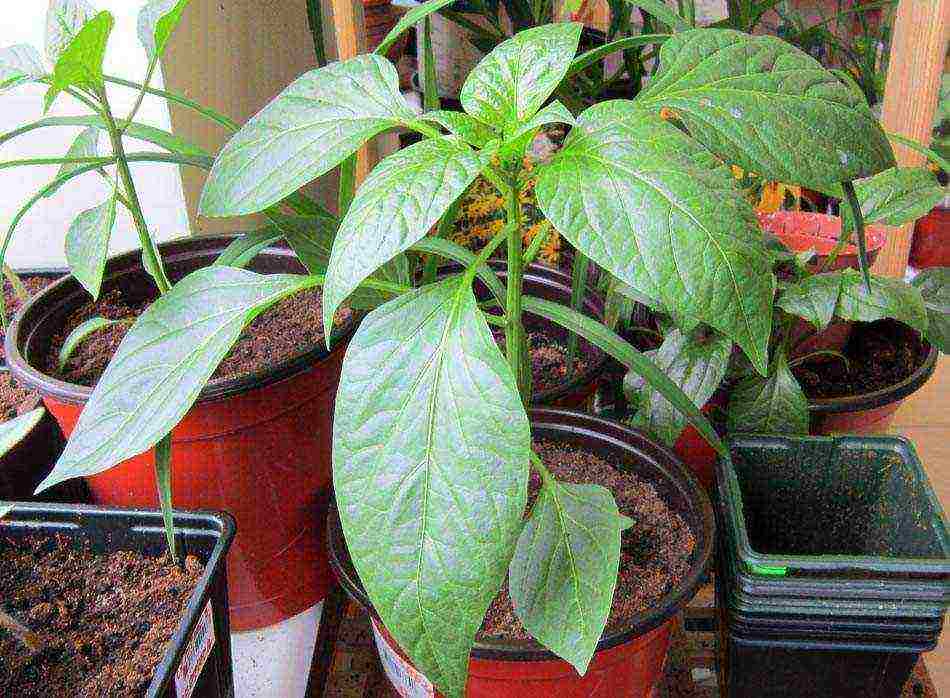 If you plan to transplant pepper seedlings outdoors, it is best to start planting it on February 20, or if the pepper variety is early maturing, plant it on March 10.
If you plan to transplant pepper seedlings outdoors, it is best to start planting it on February 20, or if the pepper variety is early maturing, plant it on March 10.
These terms will give enough time for growth and correct formation of seedlings, and will allow weather conditions to stabilize, ensuring the proper temperature regime. Such dates are relevant for the latitudes of the middle lane.
If you live in northern regions, where summer comes late and lasts a short period of time, refrain from planting pepper in open ground, because in such conditions, if you get a crop, it will be small and stunted. To grow peppers in the northern regions, you need a greenhouse. Greenhouse seedlings should be planted in late February or early March.
As for the timing of planting pepper seedlings for planting and growing exclusively in a greenhouse, there is no special framework here, since greenhouse conditions are suitable for year-round cultivation of this crop.
For southern countries, pepper seedlings should be planted in mid-January or early February.
Planting pepper seedlings in open ground should be 60-80 days of its growth. If the variety is early maturing and prone to fruiting at 60-100 days of growth, replant the seedlings at the age of 30-45 days. These criteria will allow you to independently calculate the optimal planting time for seedlings of any kind of pepper, adjusting it to the weather conditions of your region. Remember, peppers are planted in the garden only when the average daily temperature has reached a stable level of + 15 ... + 17 ° C and above.
How to choose a pepper variety and seeds?
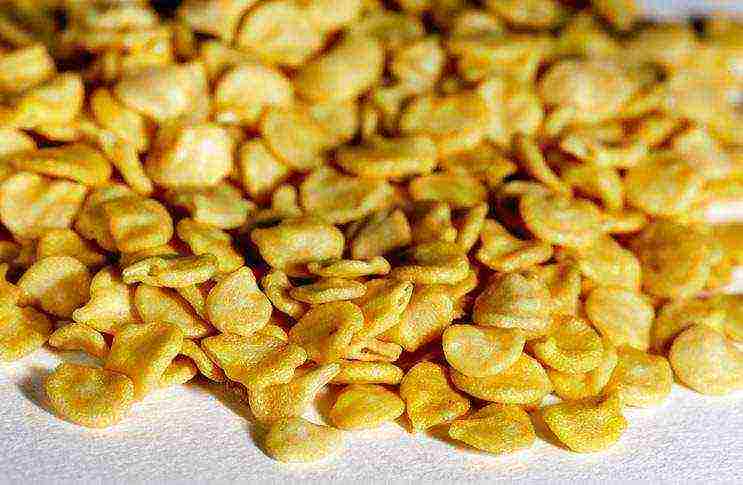
Having learned about when to plant seedlings, you should decide on the choice of the pepper itself, the care of which will be optimal in your particular case.
So, there are 3 main types of pepper, such as:
- Bell pepper.
- Bitter pepper.
- Peppercorns.
It should be noted right away that peppercorns are not suitable for growing outdoors in the conditions of the CIS countries.This type of pepper can be grown in greenhouse conditions, but it is difficult, expensive and not profitable, which means we will leave it for industrial companies that grow it in huge quantities and sell it as spices.
Sweet peppers are the most numerous and demanded plants of this type in our latitudes, and are divided into categories, such as:
- Large. The fruits of such peppers reach a mass of over 200 grams, are distinguished by thick walls, and are best suited for fresh consumption.
- Average. The fruits of such peppers reach a mass of 100-150 grams, have thinner walls, and are best suited for stuffing, preservation, freezing and any preparation for the winter.
- Small ones. The fruits of such peppers reach a mass of 20-50 grams, have very thin walls, and are intended for canning and drying, while maintaining the integrity of the fruit.
All three categories have the following types of peppers in their assortment:
- Early ripening peppers. Varieties for those who want to get everything at once.
- Mid-season peppers. Varieties for those who do not like to rush things.
- Long-ripening peppers. Varieties for those who value the process rather than the result.
Any of these peppers requires approximately the same conditions, consisting in warmth, plenty of sunlight, good watering and feeding. Choose peppers based solely on your aesthetic and gastronomic preferences. There are also varieties of pepper focused on warmer, or vice versa, colder regions, but their whole difference is reduced to minor fluctuations in relation to a comfortable growing temperature.
As for the bitter peppers, they have also gained sufficient popularity and success among domestic summer residents and gardeners, as they are distinguished by abundant fruiting, and, in general, have a piquant taste.
Everything that has been said for bell peppers is equally true for bitter peppers, with the exception of a few points, such as:
- Sweet and hot peppers should not be grown in close proximity to each other, as the sweet variety will become unpleasantly bitter.
- Seedlings of hot pepper are transplanted a little earlier than sweet, at the age of 60-65 days.
- Seedlings of hot pepper are more thermophilic, and they are transplanted at an average ambient temperature of 20-24 ° C.
- Some hot peppers can be grown on a windowsill, with frutescens being an excellent example. In addition, most hot pepper varieties can be grown in pots and pots, making them easier to carry around when needed.
Having decided on the type of pepper, you should talk about the choice of its seeds. Many people mistakenly believe that by buying a beautiful and large pepper in a large store, you can extract seeds from it and grow a similar specimen in your yard, which is fundamentally wrong. The fact is that store peppers are represented by hybrid forms, the seeds of which are either sterile, or if they give a crop, it will be much worse than the parent plant.

And here we come to the main points of choosing seeds, such as:
- Hybrid pepper seeds. If you buy fresh peppers in the store and get seeds from it, they will not meet your expectations. Despite this, special hybrid pepper seeds are sold in flower shops, which can please you with the sizes and shapes presented in large grocery stores, but at the same time require you to follow the ideal rules of agricultural technology, and their seeds, as in the case of store analogs, will be either sterile or give a poor harvest. It is recommended to purchase hybrid pepper seeds for experienced gardeners who want to grow the largest and highest quality peppers.
- Varietal seeds. These seeds are distinguished by lower requirements for their content at the seedling stage, and in general are suitable for beginners. Despite this, it is the varietal seeds that give the peppers weaker to diseases and pests, which should be taken into account by any gardener.Peppers grown from varietal seeds can give their fertile seeds, but with each generation of such peppers, they will degenerate.
Based on this, we can make an affirmative conclusion, if you want to plant and grow beautiful, healthy and tasty peppers, give preference to hybrid seeds. If you are a beginner, plant varietal seeds in the first season, the care of the seedlings of which forgives many mistakes, and if you like your crop, buy hybrid seeds next year and enjoy fruits that are in no way inferior to store counterparts.
What boxes and pots should be?
The container in which you will plant seeds and grow pepper seedlings is not of fundamental importance, and here any cups and plastic containers with a depth of about 10 cm are suitable.The diameter of the container depends on how many seeds you plan to plant, which should be located at a distance of 1.5 -2 cm from each other (seeds can be planted both in separate and in a common container).
The only requirement for the container is that it must be waterproof in order to retain moisture well and prevent the soil from drying out, which can lead to the death of seedlings.
Also, at the initial stage of seed germination, the container will have to be covered with glass or polyethylene, which means that the container where the seeds will germinate must be strong enough and retain its shape even in conditions of high humidity and heat.
How to prepare the substrate?
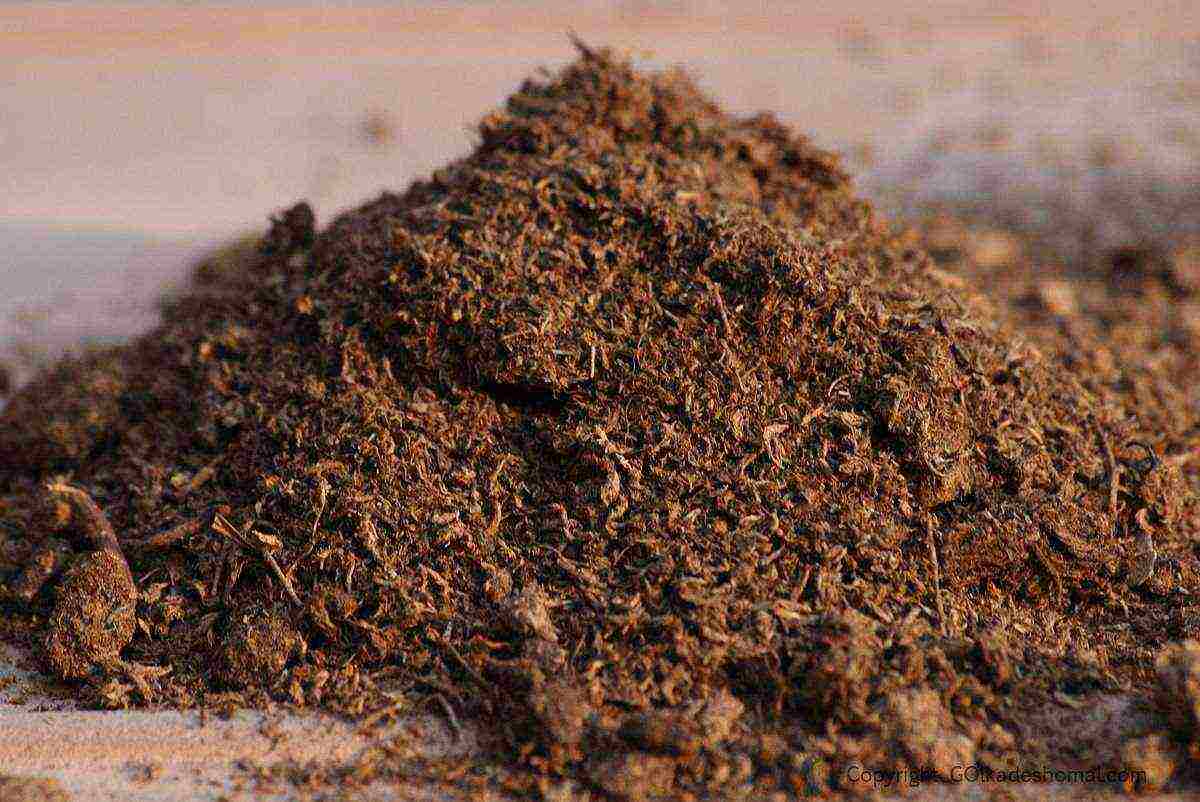
When growing pepper seedlings at home, you should properly prepare the soil substrate, which is discussed in detail in the following paragraphs:
- Take 2 parts of humus or compost and mix well until smooth.
- Take 2 parts peat and 1 part washed sand.
- Mix the peat with the sand, and then sift the resulting mixture through a sieve.
- The sifted mixture should be steamed in a double boiler for an hour in order to protect the seeds and seedlings from fungal invasions and bacteria.
- Combine the humus and the sifted mixture.
- The substrate for sowing pepper is ready.
If you don't want to mess around with preparing the substrate yourself, just buy it at any flower shop. For growing pepper seedlings, both the soil for general-purpose seedlings and the soil for pepper seedlings, which are sold in most stores, are suitable.
Remember, if you are going to grow healthy and viable seedlings, we do not advise you to use ordinary soil without preliminary heat treatment, because when germinating seedlings you will have to create high humidity in the container combined with high temperature, which can most likely activate fungal spores , especially if the soil was taken under the fallen leaves of fruit trees.
Step-by-step planting instructions
 Before planting, you should first prepare the seeds themselves. The detailed seed preparation process consists of the following points:
Before planting, you should first prepare the seeds themselves. The detailed seed preparation process consists of the following points:
- Examine the seeds you have and remove damaged, underdeveloped, spoiled samples, leaving the largest and healthiest ones.
- The remaining seeds should be additionally protected from fungi. To do this, collect the seeds, place them in gauze, and place the gauze in a solution of one of the preparations "Maxim", "Fitosporin-M" or "Vitaros". Soak the seeds in the indicated solutions according to the instructions on their packaging.
- If you do not have the above preparations, soak the seeds for about 30 minutes in a concentrated solution of potassium permanganate. After potassium permanganate, you should thoroughly rinse the seeds without removing them from the gauze.
- After washing the seeds, spread them on a damp cloth, cover with another damp cloth on top, and place them in a place whose temperature will be approximately + 25 ° C. Check the fabric periodically and do not let it dry out. If the fabric starts to dry out, dampen it.
- After 7-14 days, the seeds will sprout, and then you can start planting them.
As mentioned above, you can grow pepper seedlings in almost any container, from cups to containers. But before planting viable seeds there, the container should be washed in a solution of potassium permanganate, and then dried thoroughly.
Next, you should fill the container with the previously prepared mixture, and slightly compact it so that the top layer of soil is about 2 cm below the side of the container. how tweezers will help you.
The seeds should simply be placed on the ground, without tamping them, so as not to damage the fragile roots. The decomposed seeds should be moistened with warm water, sprinkled with a spray bottle, and covered with soil 1-2 cm thick, lightly and tamped as gently as possible. Next, water the seeds using a spray bottle; when watering, make sure that the seeds are not washed out.
After watering, cover the container with the seeds with cellophane and put it in a warm place, where the temperature will not be lower than +25 degrees. Periodically look into the container and re-irrigate the soil in order to always maintain moisture.
After 7-14 days, the first shoots will appear, and at this moment the container should be opened and placed in a bright place, the temperature of which will be at least + 15-17 degrees. Sprouted seedlings should be watered with warm water in moderation, keeping the soil moist, but at the same time, do not allow water to accumulate in the pan.
Rotate the container with seedlings from time to time so that it grows even, otherwise it will reach for the light, and may become crooked to one side.
After 3-4 weeks, the seedlings can begin to dive. The best time for picking is when 1 or 2 true leaves appear on the seedlings. Before picking, the seedlings in a common container should be well watered, and wait until the water drains into the pan. This measure will allow, when picking seedlings, to preserve maximum soil on its root system, and will protect it from mechanical damage.
The very picking of seedlings is carried out in any containers, the volume of which does not exceed 100-150 ml. The pick is carried out exclusively with single sprouts, since paired cultivation will not allow them to be transplanted into the ground in the future without damaging the tangled root system. The previously prepared soil is poured into new containers, the recipe for which is mentioned in the middle of the article, or ordinary soil for seedlings bought in a store.
The sprouts should be transplanted into the holes that will allow their root system to settle without bends and twists. The root collar can be lightly sprinkled with earth, but no more than 0.5 cm. After picking the seedlings, pour plenty of warm water over it, and put it in a bright place to grow.
Further care

Seedlings planted in separate containers need some care, the basics of which are indicated below:
- Avoid direct sunlight on the seedlings.
- Store it in a light window, or illuminate it with lamps.
- Water regularly, but avoid stagnant moisture.
- Store seedlings at +15 degrees. If the temperature drops below +13, the growth of seedlings will stop.
- Feed the seedlings 2 weeks after the pick and 2 weeks after the last feeding. The best dressings are Agricola, Krepysh, Fertika Lux, Solution;
- 2 weeks before planting the pepper in the ground, you can take it out into the fresh air in the daytime, thereby hardening it.
- After planting the seedlings in the ground, after about 10-14 days, it should be slightly trimmed, shortening the longest shoots. It is also necessary to remove all processes that are located below the main fork of the stem, so that they do not pull on the nutrients intended for the fruit.
What problems can arise when growing?
The main problems and how to solve them are indicated in the following paragraphs:
- The seeds did not hatch.To avoid this trouble, we recommend planting 50% more seeds than you need, since some of them may be sterile.
- The sprouts began to rot. You have waterlogged the soil.
- The sprouts do not grow. The temperature at the window is too cold.
- The seedlings are stretched out. There is little sunlight on the window, or overfeeding with fertilizers.
If you intend to grow large and healthy peppers, we recommend growing bell pepper seedlings, as this is one of the best species for a beginner. Sweet pepper seedlings can take up a lot of space, which means that you should prepare a lot of space for it on the site in advance, removing all objects shading the area from it.
Having a fresh, vitamin-rich product in your refrigerator all year round is far from a luxury, but a completely feasible task. It is not only an experienced gardener who can grow pepper seedlings at home. Everyone can cope with this, with a little effort, because, as they say: the eyes are afraid, but the hands are doing!
How to grow pepper seedlings at home
The choice of container and substrate for seedlings of peppers
What you need to know about seedling boxes and pots
Experienced gardeners say that it is best if the container is made of opaque plastic and will not let the sun through. Natural light is useful only for the outer part of the pepper, its leaves, but the roots can be badly damaged by it. The sun's rays slow down the development of the root system, which directly affects the growth rate of seedlings and their quality.
The best container for seedlings is a box made of opaque plastic
There are several requirements for a container for growing pepper seedlings:
- it is desirable that it be integral, not divided into sectors;
- the optimal volume of the container is 0.3-0.5 l (for 2-3 pepper seeds);
- the presence of a flat bottom so that it can be covered with a thin layer of drainage (river pebbles, broken brick, expanded clay, polystyrene).
In order to grow pepper seedlings, wooden boxes, closed on the sides, or peat pots are also ideal. But if nothing like this is at hand, then you can use ordinary disposable plastic containers. And so that the sunlight does not have access to the roots, they can be placed next to each other in a deep cardboard box.
Substrate preparation
As soon as the seedling containers are prepared, it is necessary to proceed with the selection of the substrate. The land, in order for healthy seedlings to grow, must be very fertile. It is better not to use soil from a common garden or vegetable garden, as it has high acidity and is too heavy for pepper.
The soil for pepper seedlings must be very fertile.
The substrate should consist of:
- humus (3 parts);
- turf / peat (3 parts);
- river sand (1 part)
- ash (250 g of ash is added to 5 liters of soil).
If there is no experience in making a substrate, then, in order to avoid risks, you can purchase an earthen mixture in a store. It will contain all the necessary components for the effective and rapid growth of seedlings.
Sowing seeds
Pepper seeds are planted 2-2.5 months before the planned planting in open ground. This is how long it takes for the seedlings to emerge and be ready for transplantation. Usually, seeds are planted in the ground at the very end of winter - early spring. The optimal time is considered to be the end of February - the beginning of March.
The optimal time for planting peppers is late February - early March.
Before planting seeds in a container with earth, they must be properly prepared. The preparation process includes:
- Disinfection. In order for the seedlings to be less susceptible to its characteristic diseases, both the seeds and the container where they will be located must be treated with a weak solution of potassium permanganate (1 g of potassium permanganate per 100 ml of water).The day before planting the seeds, the soil in which they will germinate should also be disinfected: for this, it must be poured abundantly with boiling water, loosened and left to dry until the next day.
Disinfection of seeds with potassium permanganate
- Soak. This procedure is necessary in order to test the seeds for germination. They are soaked for 5-7 minutes in salted water (for 0.5 l of 1 tbsp. L of salt). The planting material that has surfaced can be thrown away without regret - it will not sprout. After the good seeds have been selected for planting, they are soaked again, for 1-2 days to swell.
Soaking different varieties of peppers
- Tank and soil preparation. The bottom is covered with drainage, with a layer of no more than 1.5-2 cm. Soil, previously treated with boiling water, is poured on top. The optimum height of the ground level for planting seeds is 8-10 cm.
Drainage layer with soil for planting pepper seedlings
- Disembarkation... If the container has a rectangular shape, then it can be divided into grooves, about 5 cm wide. The planting material is planted along the grooves at a distance of about 2 cm from each other. From above, the seeds are slightly sprinkled with the same substrate.
Planting pepper with grooves
After the seeds are planted in the ground, they are covered with cling film or glass, and left in a room with a temperature of 23-25 ° C. Over the next few days, it is not necessary to water the planted material, the existing moisture will be enough for it.
Seedling care and feeding
Pepper is a light-loving plant, and even a short-term lack of light can cause irreversible changes in seedlings.
When caring for seedlings, the following conditions must be observed:
1 condition: constant temperature not lower than 20 ° С. In order for the seedlings to grow intensively, the temperature can be increased to 24-26 ° C. The main thing is not to overdo it, because the rapid increase in sprouts can weaken the stem and leaves, they will lack nutrients.
For intensive growth of seedlings, the temperature in the room should be at least 20 ° С
2 condition: moderate humidity. You need to be careful with watering seedlings: the roots are quickly affected by rot if you overdo it with soil moisture. At the same time, excessive dryness of the substrate can affect further harvest. Pepper watering is carried out:
- after 3-5 days after planting the seeds, already in moist soil;
- daily, after the appearance of the first leaves;
- 1 time in 4-5 days, but abundantly, as soon as the seedlings have grown and matured enough.
Watering pepper seedlings is carried out daily, after the appearance of the first leaves
3 condition: feeding. You need to fertilize pepper only a few times from the moment the seeds are planted into the substrate and until the already matured seedlings are planted in open ground. Top dressing is carried out in 2 stages:
- When the first 2-4 leaves appear on the seedlings. The optimal composition of top dressing for 5 liters of water includes 10 g of potassium sulfate, 10 g of urea, 30 g of superphosphate. On average, 1 liter of the prepared mixture is consumed for every 10 sprouts.
- When more than 5 leaves appear on each sprout. In terms of time, this is about 2-3 weeks after the first feeding. Often, this top dressing coincides with the dive time of the pepper. The procedure must be repeated, increasing the concentration of fertilizers by half. However, to facilitate the work, you can buy ready-made fertilizers and mixtures.
Top dressing of pepper seedlings is carried out when the first 2-4 leaves appear in seedlings
After each top dressing, it is necessary to water the soil with pepper seedlings with plain or melt water to avoid scalding the root system. You should also make sure that neither water nor fertilizer gets on the leaves of the seedlings. They are very sensitive to moisture and minerals.
Video - Tips for growing peppers
Dive pepper
The opinions of gardeners about diving pepper differ: someone advises to carry out this procedure, and someone advises not to touch the seedlings until the very moment of transplanting it into open ground.A dive should be carried out only if the seeds were planted in one whole container. Pepper leaves in the process of growth begin to cast a shadow on each other, which leads to a slowdown in the growth of seedlings or even its death. If, initially, the planting material was seated in separate pots, then this procedure can be neglected.
Preparing the ground for picking pepper
If the planting material was in very fertile soil, which was used to accelerate the germination of seedlings, then the land for picking should be chosen more adapted to the external environment. It is desirable that it be enriched with such macronutrients as potassium, magnesium and phosphorus.
Pepper soil should contain potassium, magnesium and phosphorus.
Pepper pick
Pepper roots are very sensitive to all manipulations. In order not to damage the fragile root system, it is recommended to remove the soil from the container with several shoots at once. The soil is located on a horizontal surface and is carefully separated from the roots of the seedlings.
Shrinkage of pepper seedlings
After the sprouts of the pepper are separated from the substrate, they can be pinched a little, i.e. shorten if they are too long and thin. The shoot is planted in the center of a small container in the ground, the earth around it is compacted a little. The planting field must be watered with pepper.
A. Uncooked root system. B. Root system that has passed the pick
In order for the young sprouts of pepper to feel comfortable and take root in a new place, they need to be protected from bright sunlight for 3-5 days and shortened if they are too long and thin. The shoot is planted in the center of a small container in the ground, the earth around it is compacted a little. The planting field must be watered with pepper.
Possible problems and solutions
It would seem that there is nothing difficult in growing pepper at home. However, some problems may arise on the path of novice gardeners, presented in the table below.
| The seeds did not sprout | Poor quality planting material was chosen; insufficient disinfection of the soil, container and seeds themselves |
Do not store seeds for more than 4 years; carefully carry out the disinfection procedure |
| Seedlings grow very slowly | Lack of light; lack of fertilizer; scarcity of soil; excessive moisture; the effect of light on the roots of seedlings |
Install artificial light lamps aimed at the leaves and stems of the shoots; fertilize and feed seedlings regularly; watering as the land dries up; protect plant roots from light |
| After the dive, the seedlings overgrown and stretched out | Lack of light; planting pepper too early in open ground; excessively favorable indoor climate for growth |
Plant peppers no earlier than mid-April; reduce the room temperature, where the pepper is located, to 18-20 ° С |
Both too favorable and not very favorable, the conditions of keeping pepper seedlings can play a cruel joke with it. If the seedling grows very quickly, its stem becomes very thin and unstable, it can easily break or deform. Therefore, if the growth began to rapidly gain "height and weight", then it should be suspended a little.
Landing in open ground
Growing pepper: from seeds to planting in the ground
Pepper seedlings should be planted in open ground only at a time when the average daily air temperature, even at night, does not drop below 12-14 ° C. A number of conditions must be met:
- Choose a suitable place. Seedlings should be in a sunny, draft-free place.
- Dig up the ground to the depth of the shovel bayonet.
- Fertilize the soil with peat or humus.
- Dig holes for each seedling. The holes should be placed from each other at a distance of 0.3-0.5 m from each other. Rows with seedlings should be at least one and a half meters apart.
- Pour a mineral fertilizer consisting of potassium, phosphorus and nitrogen into each well.
- Carefully remove the seedlings from the pots. There is no need to shake off the previous soil from the roots, it is better to plant seedlings in the holes with it. Then it will be easier for the pepper to adapt to changing conditions.
- Place the seedlings in the hole, sprinkle with earth. The layer of dust should be small so that the soil only covers the roots of the plant.
- Water abundantly the planted seedlings in the holes.
- After the moisture has been absorbed into the ground, it is necessary to completely fill the holes so that their surface is equal to the surface of the rest of the soil. The soil with which the pepper will be covered must first be loosened.
- Mulch with peat. Lightly sprinkle the area under the bushes with peat.
If all the rules and conditions are met, and the seedlings successfully take root, then, soon, you will have a fragrant, sweet, environmentally friendly pepper in your beds. With proper care of the plant, it will bear fruit until late autumn.
Growing pepper seedlings has its own characteristics. If you make a mistake with watering, allow sudden temperature changes, or simply incorrectly transplant, the stems will coarsen, and the potential yield of plants will noticeably decrease. In a word, there are many nuances, so today we will talk about how to grow pepper seedlings at home.
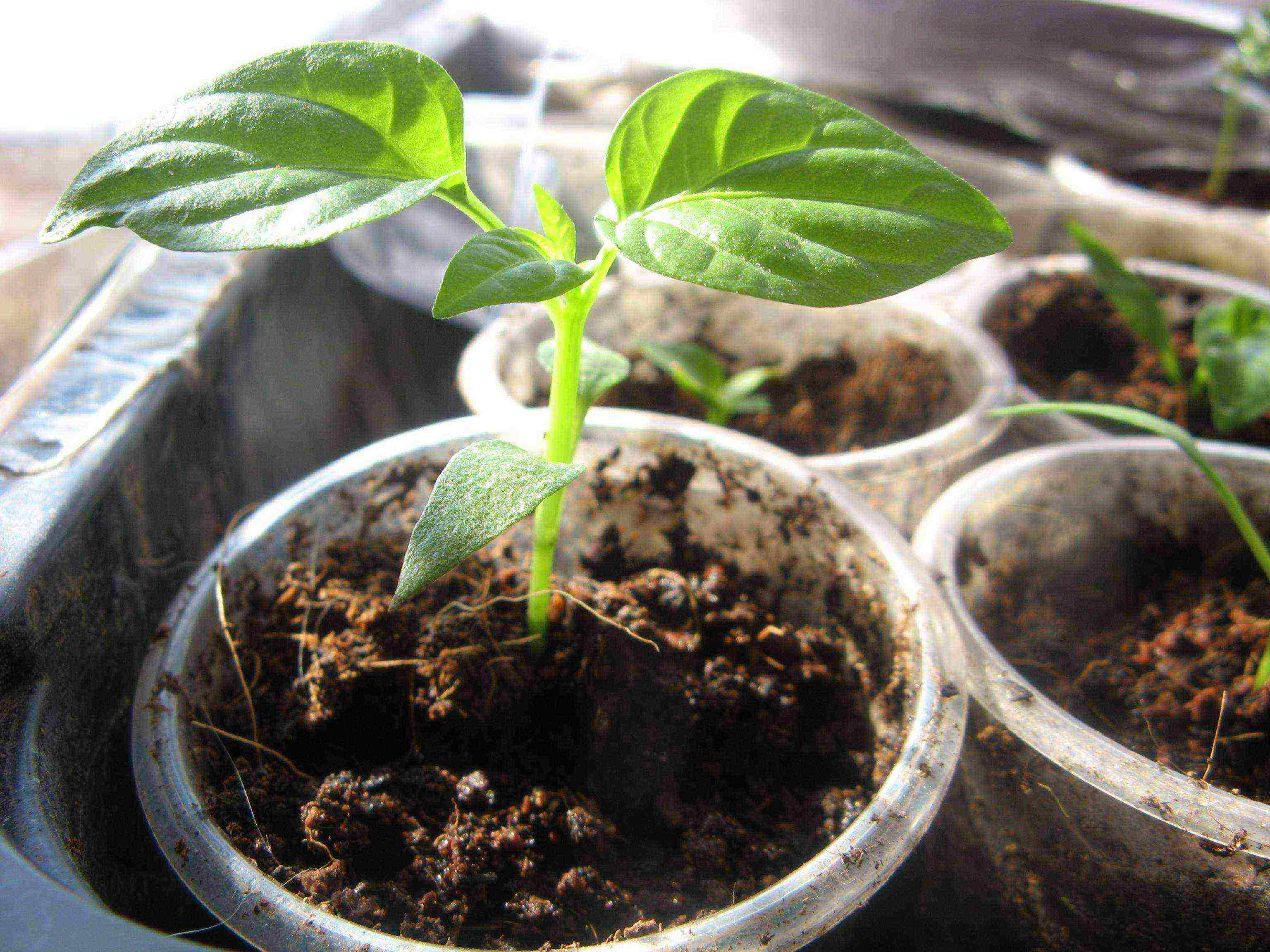
How to grow pepper seedlings at home
To begin with, if the stalk of the pepper coarsens, then because of this, it develops worse in thickness (if at the same time the watering is abundant, then it may crack at all). Such plants are unable to give a good harvest, since their ovaries will suffer from a lack of nutrients. Moreover, pepper cannot boast of resistance to root rot. If you carry out a pick after the appearance of two true leaves, as it should be for the rest of seedling vegetables, then the growth of pepper will stop, the plants will hurt for a long time, and as a result, they may even die due to the fungus.

Pepper seedlings
Note! For a good harvest in a short summer, sowing must be done early and seedlings must grow stress-free until planting. Actually, this is the main feature of growing seedlings of this culture.

Different types of peppers
About sowing dates
Fruit ripening occurs approximately 3.5-5 months after germination. The planting of seedlings must be carried out at the age of 60-80 days, which means that the optimal time for sowing is the end of February or the beginning of March (it is difficult to say more precisely, since much depends on the specific variety, for the calculation you need to know the characteristics).
Stage one. Preparing the seeds
Seeds of hot / sweet peppers are characterized by the fact that they lose their freshness quickly enough, so no one can guarantee excellent shoots. But there are ways to improve the situation somewhat - this includes disinfection of seed, soaking, hardening, etc.

Pepper seeds
Important! Do not use all of the methods described below at once - one or two is sufficient. Otherwise, you can ruin everything!
Selection
Take the seed and immerse it in a solution of kitchen salt (about 35-40 g per 1 liter of water), stir thoroughly and wait about 7 minutes. As a result, full-weight seeds will settle to the bottom, and those that float can be thrown away, since they are weak. Rinse those that remain thoroughly and place them on paper to dry. This procedure should be performed immediately before sowing.
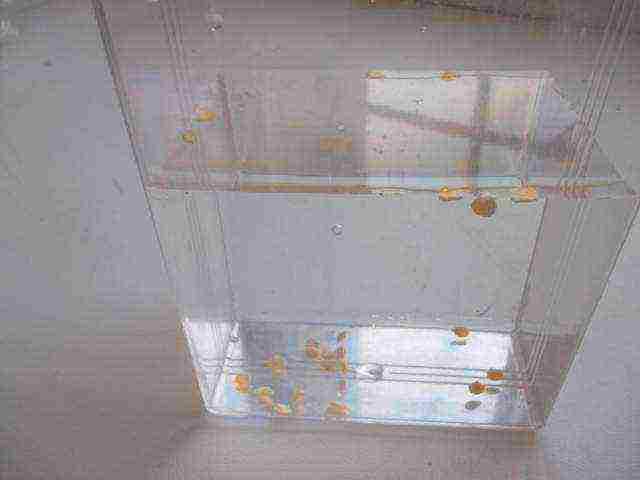
Sorting seeds with brine
Hardening
There are two ways at once how to harden the seeds of the described culture. The first is to soak the seed after disinfection. As soon as the seeds swell in water, it remains to transfer them to a place with a temperature of + 1-2 ° C for 1-1.5 days, and then dry. There is another way - here you need to expose the swollen seed to the influence of changing temperatures for 10-12 days.For half a day, the temperature should be within + 22-24 ° С, for another half day - about + 2-6 ° С. But no matter which particular method is chosen, it is important not to overdo it with hardening, otherwise the sprouts will surely outgrow.

Hardening Boglar Pepper Seeds
Etching
Take seeds sorted by size, immerse in a solution of potassium permanganate (1%) for about 10 or 15 minutes. Then rinse and dry thoroughly. This procedure should also be performed before the actual sowing.

Disinfection of seeds in a solution of potassium permanganate
Bubbling
A fairly effective procedure that needs to be carried out 7-14 days before sowing. First, fill a tall dish with water about 2/3 full and place the aquarium compressor tip on the bottom.
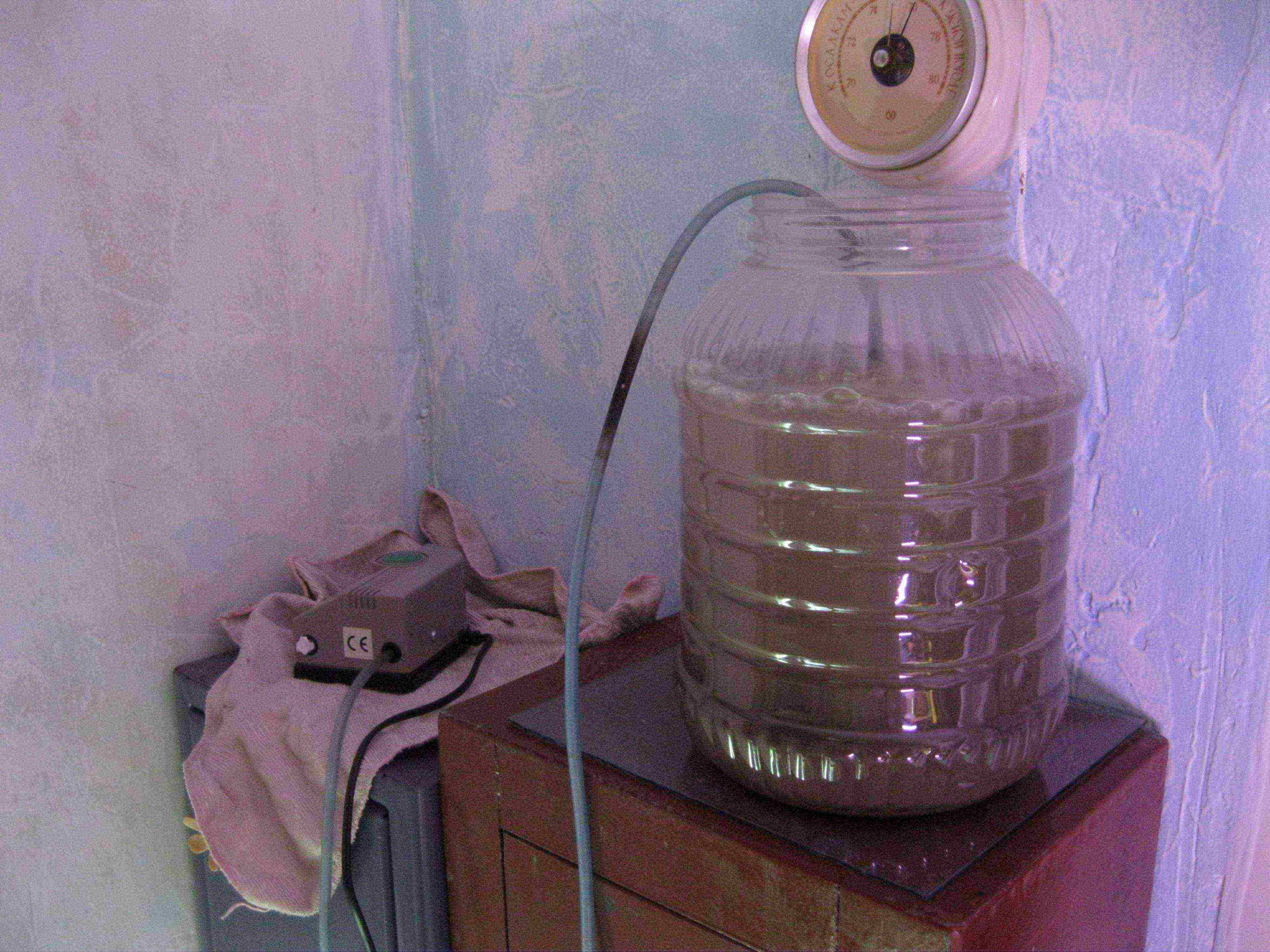
Seed bubbling
It is important that the water temperature is around + 20-22 ° C. When the water starts to bubble, submerge the seeds. It is also important that the air at this time is distributed as evenly as possible. After 1-1.5 days, remove the seeds from the container and dry, but not in the sun.
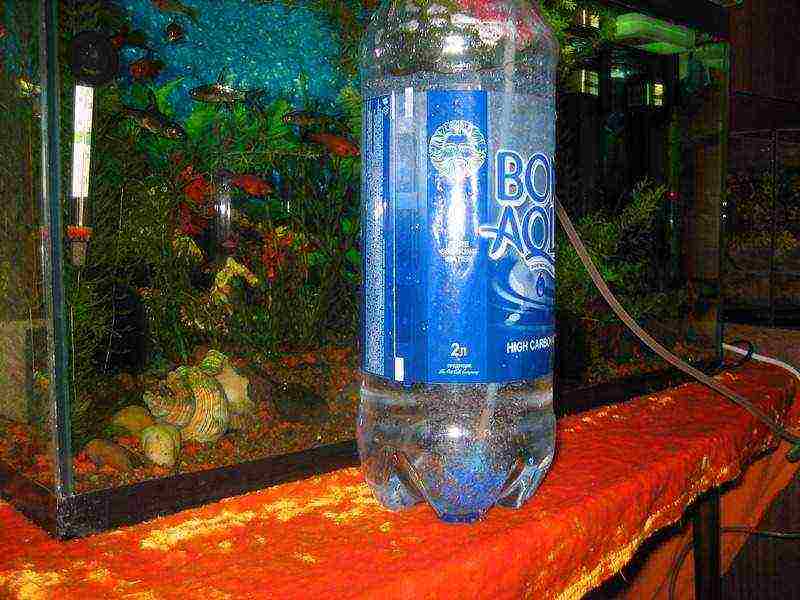
Sparging seeds in a plastic bottle with an aquarium compressor
Use of micronutrients
The seed can be treated with microelements a day or two before planting. To do this, put the seeds in gauze bags, immerse them in a solution with trace elements and keep in it for about a day. Then remove the seeds and dry them (no need to rinse).
Note! Processing using a solution of wood ash, a material containing about 30 useful microelements, is also very effective. To prepare such a product, dissolve the ash in water (1 g per 0.5 l), then insist all this for 24 hours. Remember to stir occasionally. Dip the seeds (in the same bags) into the prepared solution for 3 hours, then rinse and dry thoroughly.
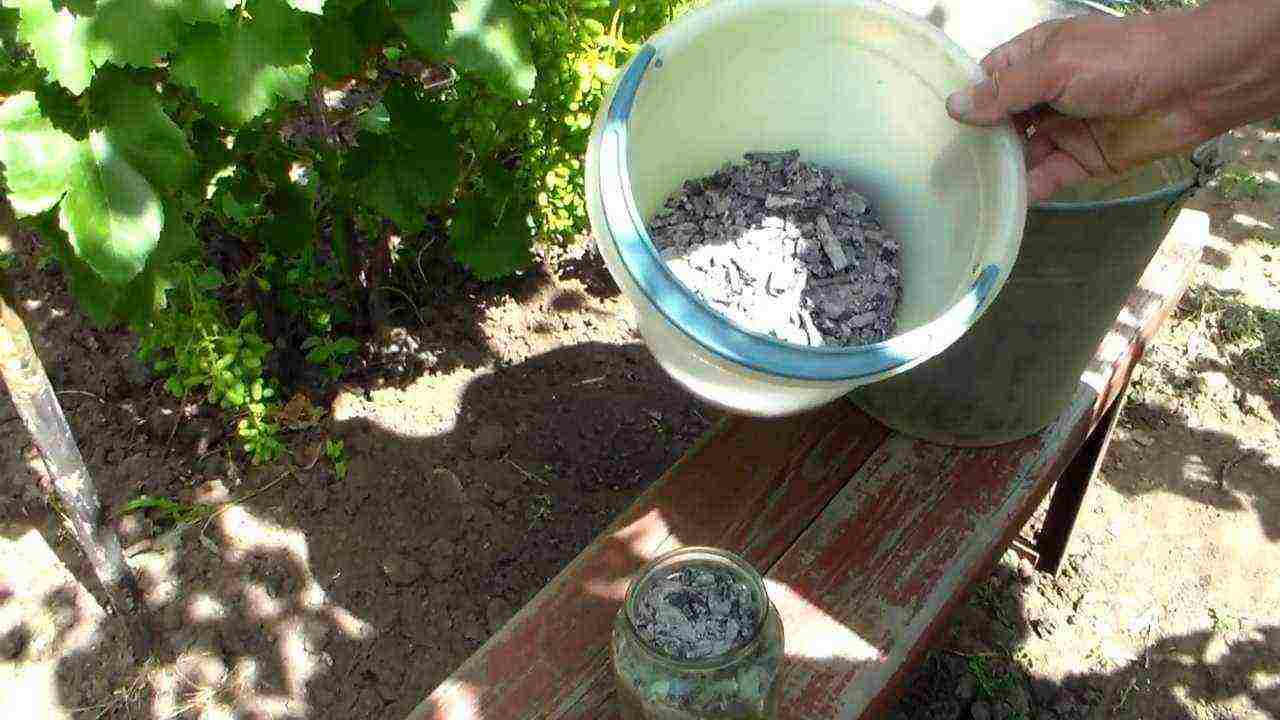
Wood ash for mortar preparation
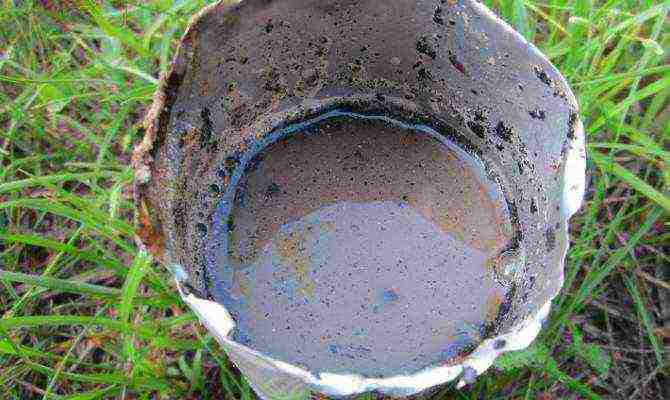
We defend the solution of wood ash
Germination
An option for the most impatient summer residents who want to get the first shoots as quickly as possible. If you are also one of them, then you can place the seed (previously disinfected) in cheesecloth, slightly moisten and transfer to some warm place. After 24 hours, the seeds will already begin to germinate. Then you can safely start sowing. But at the same time, remember that germinated seeds must be sown exclusively in moist soil, otherwise they will simply die.
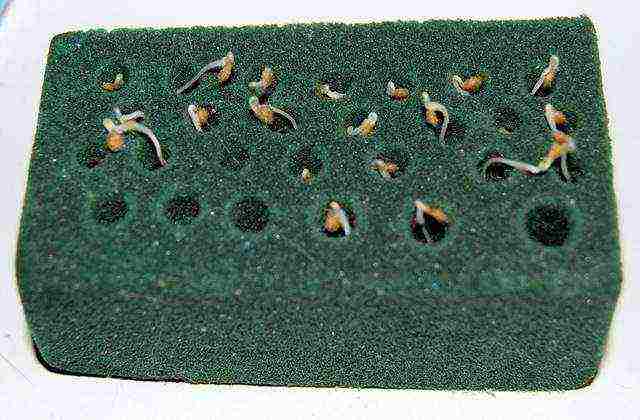
An interesting option is germinating seeds in a sponge
Stage two. Preparing the soil
You can start preparing the soil while germination is taking place. In gardening stores, you can get a ready-made mixture for peppers seedlings - you can purchase such a substrate by adding a little washed and sifted sand to it (ratio - 0.5: 3). Although many summer residents prepare soil mixtures with their own hands.
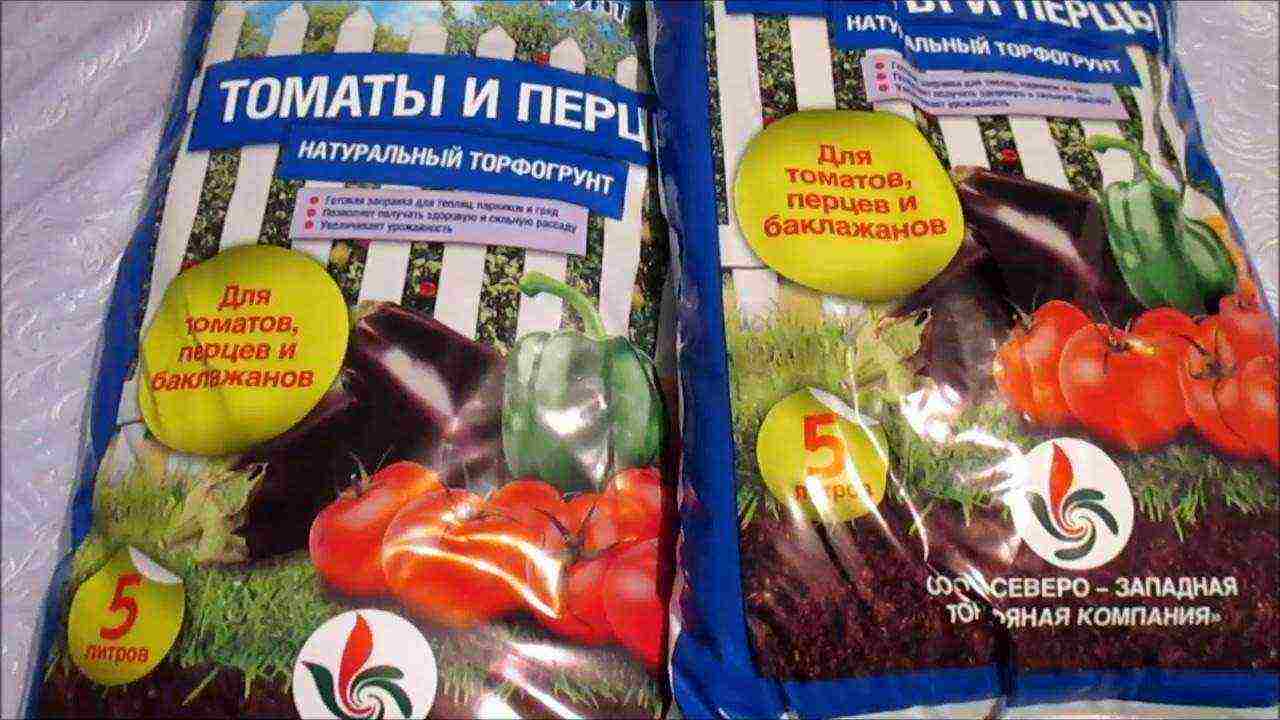
Soil for seedlings of tomatoes, peppers and eggplants
To make the substrate yourself, proceed as follows: take humus (or, alternatively, rotted compost), river sand and peat (2: 1: 2) and mix all components thoroughly. Sift the resulting mixture and then steam for about 60 minutes in a double boiler. Steam treatment, by the way, is required to protect seedlings from weeds and fungi.
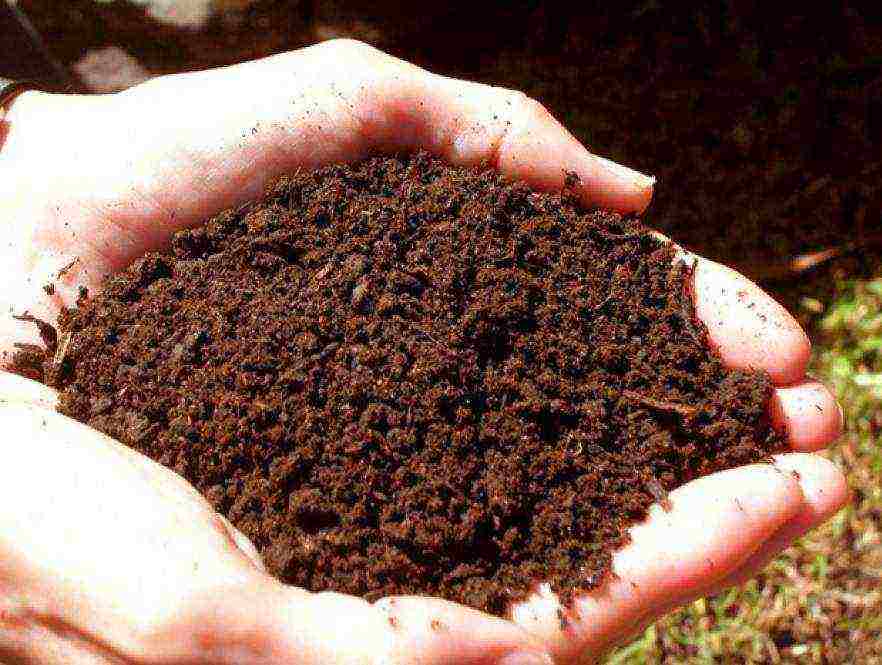
Carefully consider the choice of soil for seedlings of pepper
Stage three. We sow seeds for seedlings
The procedure consists of several simple steps, we will consider each of them separately.

Prepared Seeds
Step 1. First, treat the container where you will sow the seeds with the same potassium permanganate solution, then fill it with soil mixture (homemade or purchased). Tamp the substrate a little so that there is about 2 cm between it and the edges of the sides.
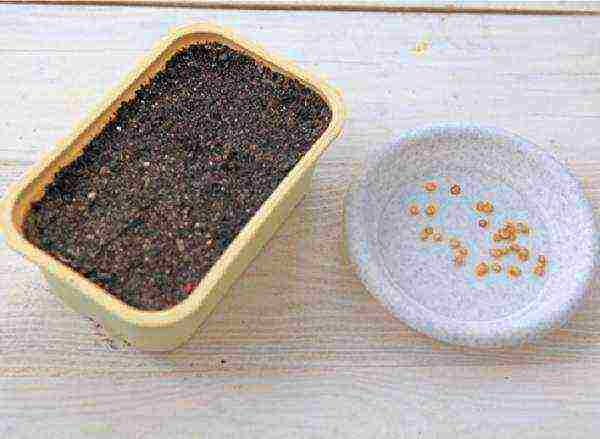
Pepper seeds and pot filled with potting soil
Step 2. Now take a pair of tweezers and use it to spread the germinated seeds in 1.5-2 cm increments.Do not sow thicker, otherwise the plants will shade each other and, as a result, stretch out.
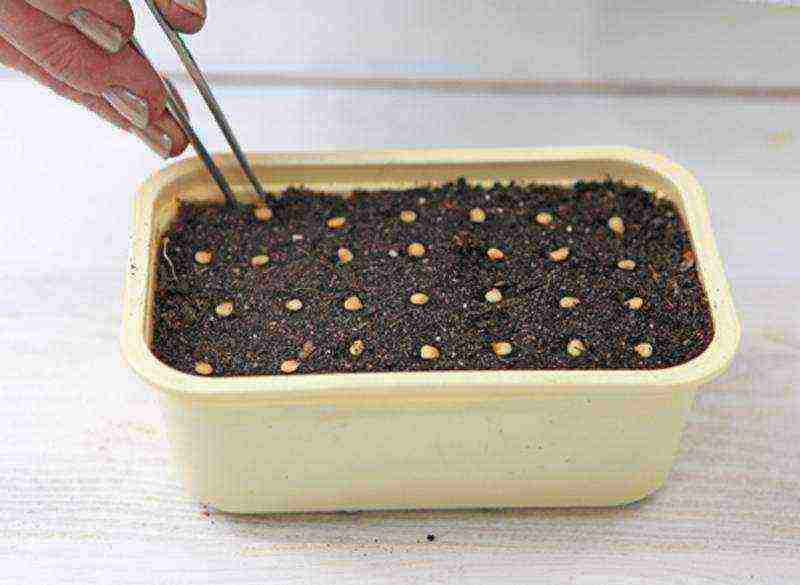
Planting seeds with tweezers
Step 3. Cover the sown seeds with a centimeter layer of the same soil mixture, then tamp them slightly. Water with the utmost care, otherwise there will be a risk of seeds washing out to the surface. Sign the varieties as needed, and then place them in a bag or seedling mini-greenhouse. In this case, the temperature should be about + 25 ° C.

Seeds are covered with a layer of soil mixture
With the appearance of the first shoots (this is often observed after 7-8 days), transfer the crops to a lighted room with a temperature of + 16-17 ° C. Watering should not be too abundant, avoid stagnant water. The water itself, by the way, should be warm. Rotate the container with seedlings regularly, otherwise they will tilt, or carry out additional lighting with a phytolamp.
Video - Features of sowing pepper seeds
Stage four. Dive pepper
To reduce the risk of root damage by dangerous diseases (especially root rot), dive the pepper after the appearance of two true leaves, and deepen it minimally (by 5 mm) or do not deepen it at all. Although another method is quite popular - the seedlings are dived at the stage of the cotyledons, that is, when the seedlings tolerate the transplant most easily. When using the second method, deepening is allowed up to the cotyledon leaves themselves, but remember that it is designed more for professional greenhouses. In such greenhouses, the temperature decreases when shoots appear, the seedlings are provided with high-quality lighting, and the seedlings are obtained with a dense and short hypocotal knee. If we talk about home cultivation, then the seedlings in this case are always stretched out, therefore, the first method is preferable.
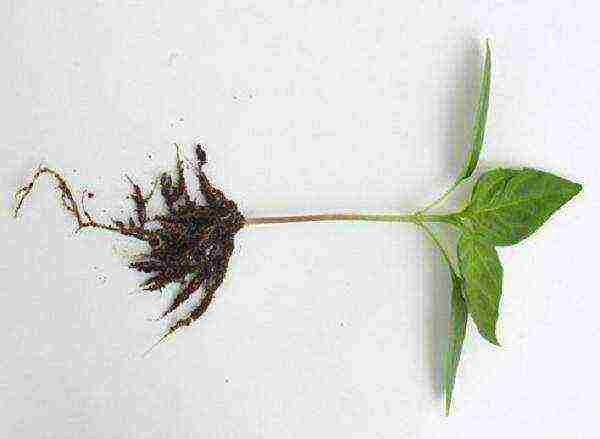
Seedling ready for picking
Prepare the nutrient mixture first. One of the popular recipes involves the use of peat, turf soil, humus, fertilizers and a loosening component (for example, the same river sand). At the same time, it is important that the finished mixture is 35-45% organic. It will be great if you additionally add mineral fertilizer, while the proportions should look something like this (per 1 m3 of humus mixture): ammonium nitrate - 600-800 g, potassium chloride - 800 g, superphosphate - 1000-1500 g. If the mixture is peat , then the proportions will be different: ammonium nitrate - 600-800 g, potassium chloride - 1000 g, superphosphate - from 4 to 8 kg.
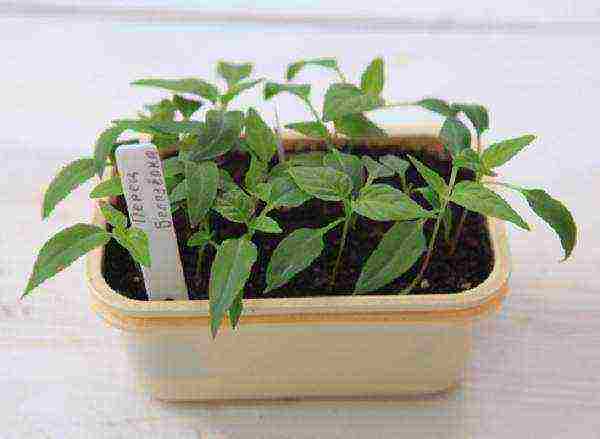
This seedling of peppers can already be dived
First, water the soil in the general container and wait for the excess moisture to drain into the pan. The development of pepper is rather slow, so you can use small pots (150 ml each) for diving. In this case, the plants will quickly get used to the new soil. The further sequence of actions is shown in the table below.
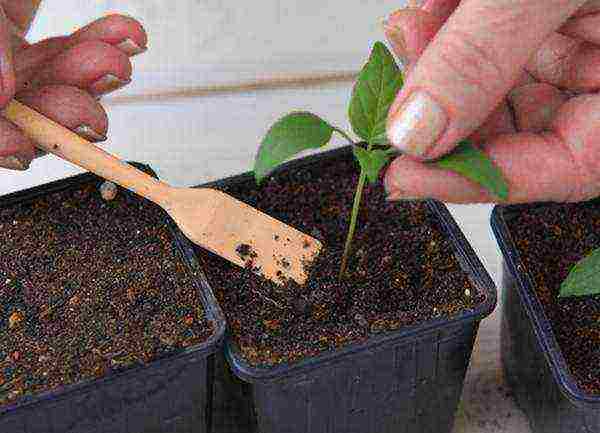
Seedling picking
Table. The process of diving pepper seedlings.
|
Step 1 |
So, when each plant has 2 true leaves (and this usually takes 3-4 weeks), start transplanting into separate pots. |
|
Step 2 |
Fill the pot with the prepared potting soil, water and level well. Then make a hole in the substrate. |
|
Step 3 |
Take a seedling and, gently holding it, place it in the hole. Try to hold the plant by its "ears", otherwise there will be a risk of damage to the stem. |
|
Step 4 |
Sprinkle the seedling with substrate, tamp it a little. You can deepen the neck a little, but, as noted above, by a maximum of 5 mm. |
Note! After picking, water the potting soil while gently holding the plant. If the soil subsides, you can fill it up a little.

Dive seedlings are watered
In the end, all that remains is to put the pots on the windowsill and shade it at first. Also, make sure that the temperature of the substrate in the containers is at least + 15 ° C. So, if it drops to at least + 13 ° С, the plants will stop growing.
Sowing and growing flower seedlings
The ideal planting soil should be light and loose, have a porous structure and adequate aeration, and match the type of crop intended for the soil. Read more in this article.
Stage five. Care, feeding
Before transplanting peppers into a greenhouse or garden, seedlings should be fed at least twice:
- two weeks after the dive;
- another two weeks after the previous feeding.
It is important that only liquid fertilizers are applied. You can use "Solution", "Agricola", "Krepysh" and so on. In the last days of spring, when it becomes much more spacious on the windowsills, since the seedlings of other crops will be hardened, you can transplant the peppers into pots of 0.8-1 liters. If you transplant with an earthen clod, then the growth of plants will not stop. As for the composition of the soil mixture, it can be any of the above options. Additionally, add double superphosphate (1 tbsp. Spoon) and 120 g of wood ash or 3 tbsp. spoons of a special agent "Signor Tomato" (based on 10 kg of soil mixture).
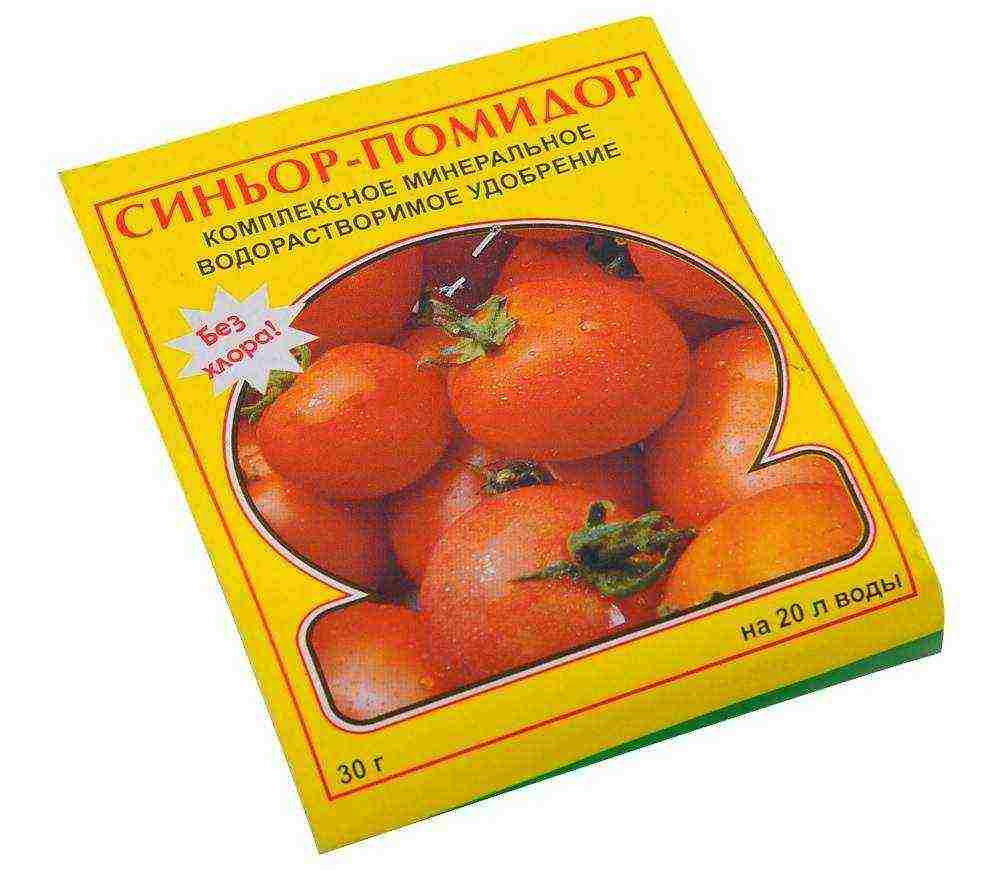
Fertilizer "Signor Tomato"
About 14 days before the transplant, you can start hardening by taking the containers to fresh air. Do not forget to shade the seedlings at first, and also protect them from drafts.
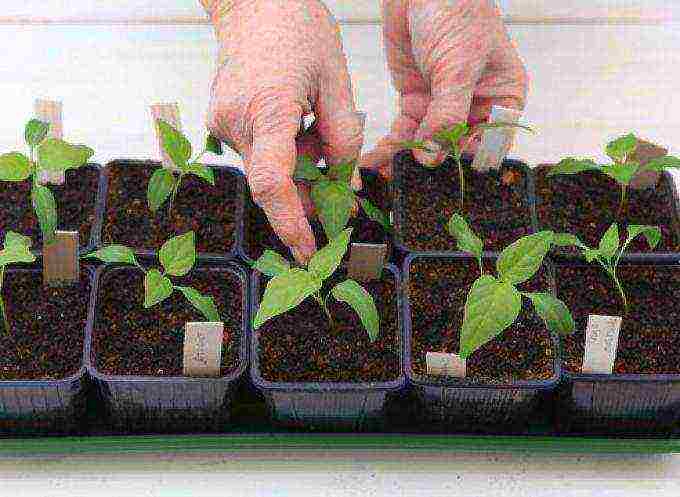
Hardening of seedlings
Stage six. We carry out transplantation into open ground
After the buds appear, you can start transplanting. But it is necessary that the average temperature outside is about + 15-17 ° С.
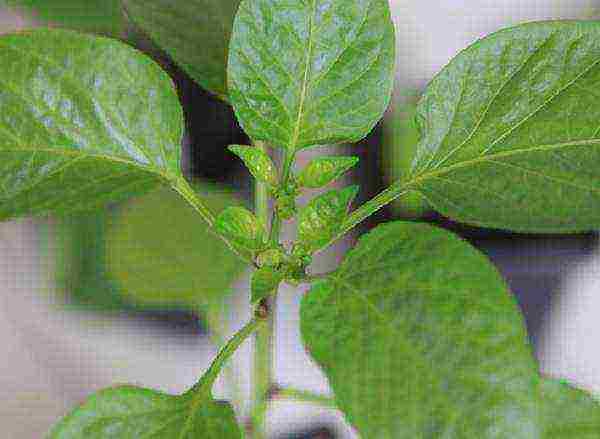
At the stage of formation of the first buds, seedlings can be planted in the ground
Heavy cold soil is not suitable for the culture, which means that if your soil is clay, be sure to add humus and peat. After that, dig the area into the bayonet of the shovel, carefully align. Make holes with a step of 0.5 m and a row spacing of about 0.6 m. The depth of each hole is determined so that the root collar is flush with the soil surface after planting. Next, add 1 tbsp. a spoonful of mineral fertilizer, which contains potassium, phosphorus and nitrogen, in each well, evenly spreading over the surface. Carefully remove each plant with an earthy clod, being careful not to damage the latter. Often there are no difficulties with this.

The process of planting pepper seedlings
Place the plant in a hole, fill it with 1⁄2 or a little more soil (roots must be covered), then pour (about 3 liters of water per hole). As soon as the water is absorbed, fill the wells completely. If there are several varieties, supply labels with the names.

Watering and backfilling holes
In the end, all that remained was to mulch the plantings with peat. If necessary, you can tie the bushes to the supports. If at night the temperature drops below + 14 ° C, cover the pepper with covering material in arcs.
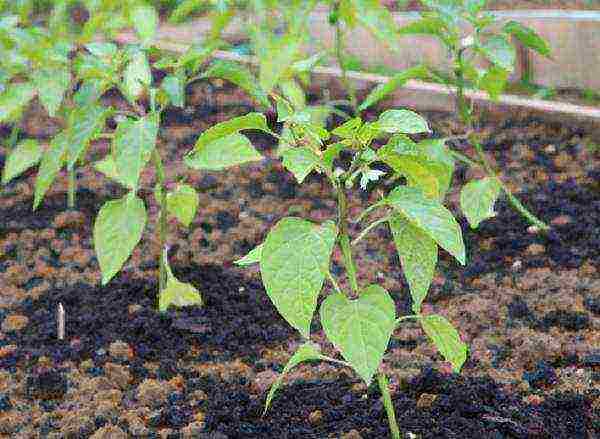
Seedlings are mulched with peat
An alternative is the use of peat tablets
When using peat tablets, the planting dates should remain the same, unless you can shift them to the first days of March (the fact is that seedlings without a dive will develop much faster). The seed preparation procedure is the same as for normal growing.

Growing pepper seedlings in peat tablets
Note! Plant seeds germinated and always wet (otherwise, some of them may simply not sprout). Although you can put several seeds in each tablet at once, and remove excess shoots in the future.
First, prepare peat tablets, the diameter of which is 3 cm. Place them in a plastic tray, then pour warm water (always boiled). When the tablets are swollen, they will increase 5 times and turn into a kind of columns. If they are not completely swollen, you can add more water. When moisture absorption stops, drain off the remaining liquid.
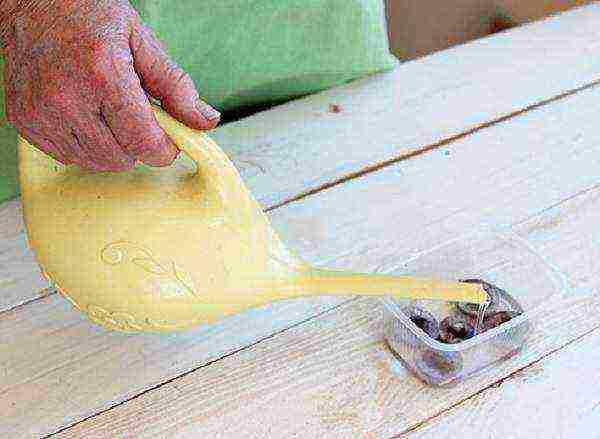
Peat tablets are filled with water
Deepen the holes at the top of the tablets to about 1.5 cm. Carefully place the germinated seeds in these holes, being careful not to damage anything.

Planting pepper seeds in peat tablets
After sowing, cover the holes with nutritious soil.

The wells are filled with soil mixture
Place the container in a PET bag or cover with a transparent lid. Transfer to a warm room where the temperature is approximately + 25 ° C.
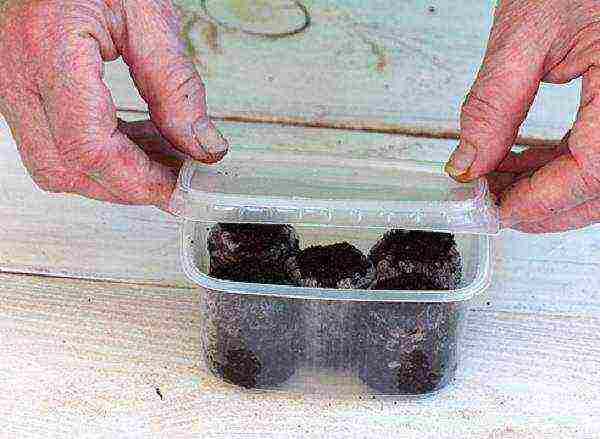
The tray is closed with a lid
After a week or a little more, when there are the first shoots, remove the shelter, and transfer the container to a lighted place. Try to keep the tablets moist and keep the temperature as described above. No feeding is required in this case. If excess water remains after refilling, remove it. And when the roots sprout through the protective shell of the tablets, you can pick into separate pots. At this stage, plants usually have 2-3 leaves.
For transplanting, you can use the same soil mixture as in the case of traditional cultivation. The volume of the pots should be approximately 500 ml. Fill each such pot with about 4 cm of substrate, then place the tablet with the plant. Spread the protruding roots evenly over the substrate.

Picking pepper seedlings into separate pots
Fill the resulting voids in several layers, lightly tamping each of them. As a result, about 1.5 cm should remain between the soil mixture and the edges of the pot. It is also important that the root collar is 5 mm deep.

The empty space in the pot is filled with soil.
Pour the pepper over at the end.
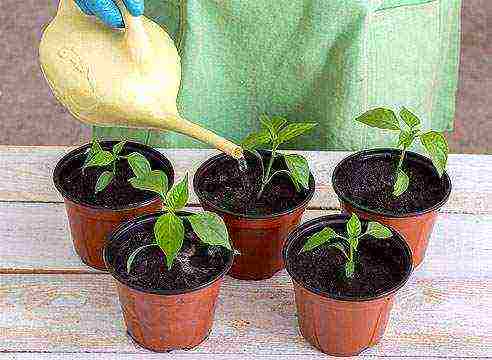
Watering dived pepper seedlings
Do this from the edge of the container. If the top of the tablet opens up as a result, you can add some more substrate. Follow-up care is practically the same as described above.
Video - Features of caring for pepper seedlings
Today we'll talk about how to grow pepper seedlings at home? The step-by-step instructions are given below.
Growing pepper seedlings at home
Let's discuss in more detail how to grow pepper seedlings at home?
For peppers you need to make up a light nutritious substrate from turf or garden soilmixed with humus, peat and a small amount of washed sand. It is not worth taking land from a greenhouse or from a flower bed, the best option is the soil on which the herbs grew.
The lighter the substrate, the
seeds germinate better
... Before planting seeds, it is recommended to ignite the soil to destroy insect larvae.
 Growing pepper seedlings from seeds. You can plant seeds in containers or peat pots. Before planting, the seeds are treated with a growth stimulant and soaked to swell.
Growing pepper seedlings from seeds. You can plant seeds in containers or peat pots. Before planting, the seeds are treated with a growth stimulant and soaked to swell.
Pepper does not tolerate transplanting and picking well; it will have to be transferred to a new place of residence (in a greenhouse or in the ground) using the transshipment method. The fragile root system is easily damaged and difficult to recover.
A convenient option for growing peppers for seedlings at home are pieces of plastic film, which gardeners themselves call "diapers". Growing in "diapers" is very economical, shoots develop well, moisture does not stagnate in the soil. In this way, you can grow good and healthy seedlings without picking.
The manufacturing process is simple. The thick plastic is cut into rectangles the size of a notebook sheet. A portion of the prepared soil is laid out on each workpiece, a pepper seed is placed in it. Plastic with soil is rolled up in the form of a cylinder, the process is a bit like swaddling a baby.
The lower part of the workpiece is tucked tightly, a clerical elastic is put on the upper part to fix it. The resulting cups are tightly placed in a deep tray. If several varieties are planted, it is worth marking each glass and entering the name of the variety in a notebook.
Before transplanting, it is enough to remove the rubber band from the plastic cup, remove the film and place the earthen lump in the prepared hole. With this method, the root system is not injured, seedlings take root in a new place without problems, do not get sick and develop well.
You can clearly see how pepper seedlings are grown in the photo below:





Kitchen garden on the windowsill
How to properly grow pepper seedlings at home? A very important point is the correct placement of the landings at home. Pepper shoots usually exposed on the windowsill of the south, south-east or south-west window... To create the optimal atmosphere, it is best to cover the window with plastic wrap on both sides. This technique will provide a greenhouse effect, the plants will not suffer from drafts.
You can ventilate an impromptu greenhouse using a window, opening it at a strictly defined time.
At what temperature are pepper seedlings grown? For seed germination optimal temperature from 25 to 28 degrees... When sprouts appear on the surface of the soil, the temperature should be reduced to 22-25 degrees.
How to harden pepper seedlings? Some gardeners recommend short-term hardening with a temperature drop of up to 20 degrees. This temperature regime lasts no more than 2 days after the emergence of sprouts, then the temperature rises.
The atmosphere in a window greenhouse must be stable. A decrease in temperature inhibits development, and excessive heat can cause the death of the sprouts. It is strictly forbidden to put boxes with seedlings on the battery or in the immediate vicinity of it. Strong overheating dries out the soil and roots.
Secrets of proper cultivation
 How to properly grow pepper seedlings at home? Growing peppers need a short day of light, while they love bright lighting.
How to properly grow pepper seedlings at home? Growing peppers need a short day of light, while they love bright lighting.
To ensure the desired mode, lamps for illumination are mounted on the window. At 19 o'clock the container with the seedlings is covered with an opaque breathable material, in the morning it is removed. As a result, the seedlings develop well and do not outgrow.
At home, pepperoften affected by mites, aphids and other pests... Effective bio-protection means (for example, Fitoferm) will help to destroy insects. You can replace purchased preparations with infusion of calendula, garlic, needles or onion peels. Affected plants are sprayed with a spray bottle, the procedure is repeated until the pests are completely destroyed.
Only completely healthy and strong plants can be planted in a greenhouse or in open ground. Transhipment together with an earthen clod is carried out, when the earth warms up to 15 degrees... Preliminary spilling of the wells with hot water helps to improve survival.
Watering and fertilizing
Immediately after sowing, the soil in the container or pots is moistened with a spray bottle. When sprouts appear on the surface of the soil, you can start watering from a spoon. You cannot pour seedlings, stagnation of moisture in the soil causes rotting of the roots and the appearance of a "black leg".
For irrigation, warm settled water is used. Ideal if the water temperature is the same as the air temperature. Irrigation with cold water is excludedthis can cause shock and plant death.
You need to water the grown seedlings twice a week, making sure that the soil does not dry out. If the leaves begin to fade, it is worth spraying with warm water. An aqueous solution of a growth stimulant will also help improve the condition of the seedlings. Watering with a stimulant is useful immediately after seed germination and after the formation of 2-3 true leaves.
 When the first true leaf appears on the plants, you can start mineral dressing.
When the first true leaf appears on the plants, you can start mineral dressing.
An aqueous solution of complex fertilizers is applied to the soil. After the appearance of the third leaf, feeding is repeated. Potassium humate has a positive effect on root development.
After transplanting peppers into a greenhouse or into the ground, fertilizers are applied twice a month.Watering takes place in the usual mode for seedlings, 2 times a week.
To maintain optimal moisture content and avoid crust formation on the soil surface, it is better to mulch the soil with humus, straw, peat or sawdust.
The age of the seedlings is very important for the future harvest. Overgrown peppers should not be planted in a greenhouse or garden bed.... In order to get the right size and development of seedlings, it is important to accurately calculate the seed sowing time. Having paid attention to all the little things, the gardener can count on good plant development, timely formation of ovaries and abundant fruiting.
So, the main topic of the article is pepper seedlings: how to grow them strong and healthy? We discussed the main points of growing, and also gave advice on how to grow peppers from seeds at home for seedlings?
Useful materials
Read other articles on pepper seedlings:
- How to grow black peppercorns, chili, bitter or sweet at home?
- The main reasons why the leaves of the shoots curl and the seedlings fall or stretch out.
- Planting dates in the regions of Russia and the peculiarities of cultivation in the Urals, Siberia and the Moscow region.
- Learn recipes for yeast-based fertilizers.
Useful video
Step-by-step instructions for growing pepper seedlings:


